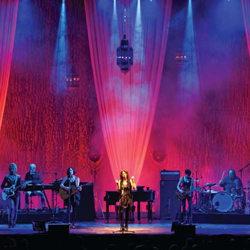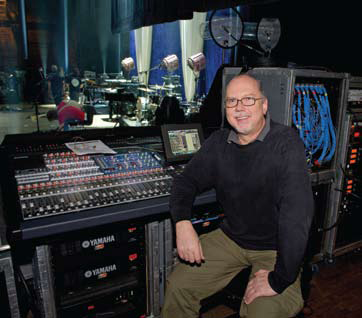
With slow ticket sales and myriad other factors combining to halt the return of Lilith Fair last summer, Sarah McLachlan, one of Lilith’s original organizers, is still moving forward, as evidenced by her current Laws of Illusion concert tour.
The size and scope of the tour has been scaled to fit within the confines of theatres and other venues seating from 2,000 to 3,500, leaving much smaller footprints on North America’s highways.
In fact, all of the gear, the entire band, and supporting crew can be packed into just two trucks and two buses.
Yet some things haven’t changed, including the fact that the star of the show is still joined onstage by a stellar group of musicians.
McLachlan’s band this year includes impeccable talent like that of guitarist Luke Doucet, bassist Butterfly Boucher, and Melissa McClelland on backing vocals and guitar.
“It’s no secret that we had a terrible summer last year,” acknowledges McLachlan monitor world maven Dave Pallett, who’s been on the road with the mezzo-soprano since 1992.
“As a result we’ve made a lot of changes, and in our new leaner, stripped-down configuration, things have gotten better. We’ve found our market and the right venues. It’s good to look out and see a full house again.”
Pallett, who used to command his stage mixes for McLachlan from behind the relatively wide open spaces of a Yamaha PM1D, now orchestrates what’s heard onstage using a PM5D.
Utilizing everything the desk has to accommodate just over 50 inputs, he confides that he’s “just making it,” having only stooped to allowing two things to be submixed on keys as a compromise, if such a thing can even be called that.
In Lockstep
Out at front of house for a good portion of the tour earlier this year, Paul Sarault remained in lockstep with the sensibilities of the show, mixing for the crowd with a compact Avid VENUE Profile System.
Standing in for longtime McLachlan house engineer Gary Stokes – who took a hiatus from this, his usual gig, to mix for k.d. lang – Sarault manned the house faders until mid-February, when he left to return to one of his other regular gigs with Yanni. In turn, Sean Sullivan took his place, and remains there as of this writing.

From the work surface of his Profile, Sarault relies strictly upon Waves plugins to create a vocal chain providing four inserts for each vocal: de-essing, EQ, multi-band compression, and limiting.
Waves plug-ins were his choice for delay and reverb as well. Scenes stored within the Profile are straightforward, including mutes, delay changes, and the rest of the basics.
“My stored scenes offer a good starting point for each song,” Sarault says. “After that it really comes naturally with a band like this.”
“If you come prepared, pay attention, and realize that the details are everything, the musicians will provide you with everything else you need. It’s not the console, not the microphone, none of that.”
“It’s a lot like cooking a fine meal. You can be the best chef with the nicest kitchen, but if you don’t have the right ingredients, nothing is going to taste right.”
McLachlan uses a pair of SKM 5200 vocal microphones from Sennheiser during the show, both of which sport Neumann KK 105 supercardioid capsules. Kept at her piano and downstage center, these wireless mics mark the first time she has definitively cut the cord.
“Sarah had been on hardwired mics for years,” Pallett reveals. “The logic was always that since the show is all about her vocals, a hardwired mic was the only choice in terms of quality and reliability.”
“But she’d been keen about going wireless for a while in terms of gaining the freedom, and we finally relented. This was a major step, and it’s been solid so far.”
